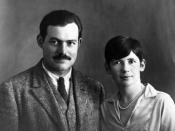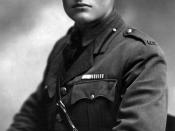Through history women have fought for equal rights and freedom. This tension is derived from men; society, in general; and within a woman herself. In the nineteenth century, women in literature were often portrayed as submissive to men. Literature of this period often characterized women as oppressed by society, as well as by the male influences in their lives. This era is especially interesting because it is a time in modern society when women were still treated as second-class citizens. Two interesting short stories, "Hills like White Elephants" and "The Yellow Wallpaper" focus on a woman's plight near the turn of the nineteenth century. Both authors, Hemmingway and Gilman, leave an open end to the stories and allow readers to create their own ending, in turn causing them to take part in the action while reading. These stories require more effort from the reader, but seem to turn out differently for every reader making them a bit more interesting.
Hemingway led a difficult life full of martial affairs and misfortune. Some of these experiences have set the foundation for Hemingway's greatest works. This essay will analyze the influence that Hemingway's separation from Pauline and divorce from Hadley had on "Hills like White Elephants." Before writing "Hills like White Elephants," Hemingway had been residing in Paris with his wife Hadley and son, Bumby. During their stay in Paris, Hadley and Ernest Hemingway met a woman named Pauline Pfeiffer. Pauline was more of a friend to Hadley than Hemingway was. Pauline did not think much of Hemingway at first, she thought he was lazy and a no-doer. Later Pauline and Hemingway fell in love and had an affair. Once Hadley knew of their affair, Hemingway requested a divorce. Hadley agreed under one condition, Hemingway and Pfeiffer had...


